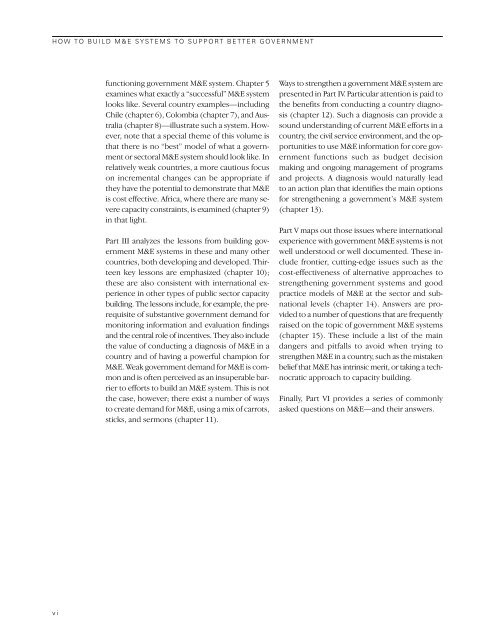How to Build M&E Systems to Support Better Government How to ...
How to Build M&E Systems to Support Better Government How to ...
How to Build M&E Systems to Support Better Government How to ...
You also want an ePaper? Increase the reach of your titles
YUMPU automatically turns print PDFs into web optimized ePapers that Google loves.
HOW TO BUILD M&E SYSTEMS TO SUPPORT BETTER GOVERNMENT<br />
functioning government M&E system. Chapter 5<br />
examines what exactly a “successful” M&E system<br />
looks like. Several country examples—including<br />
Chile (chapter 6), Colombia (chapter 7), and Australia<br />
(chapter 8)—illustrate such a system. <strong>How</strong>ever,<br />
note that a special theme of this volume is<br />
that there is no “best” model of what a government<br />
or sec<strong>to</strong>ral M&E system should look like. In<br />
relatively weak countries, a more cautious focus<br />
on incremental changes can be appropriate if<br />
they have the potential <strong>to</strong> demonstrate that M&E<br />
is cost effective. Africa, where there are many severe<br />
capacity constraints, is examined (chapter 9)<br />
in that light.<br />
Part III analyzes the lessons from building government<br />
M&E systems in these and many other<br />
countries, both developing and developed. Thirteen<br />
key lessons are emphasized (chapter 10);<br />
these are also consistent with international experience<br />
in other types of public sec<strong>to</strong>r capacity<br />
building. The lessons include, for example, the prerequisite<br />
of substantive government demand for<br />
moni<strong>to</strong>ring information and evaluation findings<br />
and the central role of incentives. They also include<br />
the value of conducting a diagnosis of M&E in a<br />
country and of having a powerful champion for<br />
M&E. Weak government demand for M&E is common<br />
and is often perceived as an insuperable barrier<br />
<strong>to</strong> efforts <strong>to</strong> build an M&E system. This is not<br />
the case, however; there exist a number of ways<br />
<strong>to</strong> create demand for M&E, using a mix of carrots,<br />
sticks, and sermons (chapter 11).<br />
Ways <strong>to</strong> strengthen a government M&E system are<br />
presented in Part IV. Particular attention is paid <strong>to</strong><br />
the benefits from conducting a country diagnosis<br />
(chapter 12). Such a diagnosis can provide a<br />
sound understanding of current M&E efforts in a<br />
country, the civil service environment, and the opportunities<br />
<strong>to</strong> use M&E information for core government<br />
functions such as budget decision<br />
making and ongoing management of programs<br />
and projects. A diagnosis would naturally lead<br />
<strong>to</strong> an action plan that identifies the main options<br />
for strengthening a government’s M&E system<br />
(chapter 13).<br />
Part V maps out those issues where international<br />
experience with government M&E systems is not<br />
well unders<strong>to</strong>od or well documented. These include<br />
frontier, cutting-edge issues such as the<br />
cost-effectiveness of alternative approaches <strong>to</strong><br />
strengthening government systems and good<br />
practice models of M&E at the sec<strong>to</strong>r and subnational<br />
levels (chapter 14). Answers are provided<br />
<strong>to</strong> a number of questions that are frequently<br />
raised on the <strong>to</strong>pic of government M&E systems<br />
(chapter 15). These include a list of the main<br />
dangers and pitfalls <strong>to</strong> avoid when trying <strong>to</strong><br />
strengthen M&E in a country, such as the mistaken<br />
belief that M&E has intrinsic merit, or taking a technocratic<br />
approach <strong>to</strong> capacity building.<br />
Finally, Part VI provides a series of commonly<br />
asked questions on M&E—and their answers.<br />
vi
















![[PDF] Community Development Toolkit - CommDev](https://img.yumpu.com/48616495/1/184x260/pdf-community-development-toolkit-commdev.jpg?quality=85)
